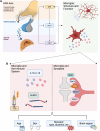Stressed Microglia: Neuroendocrine-Neuroimmune Interactions in the Stress Response
- PMID: 37279575
- PMCID: PMC11491833
- DOI: 10.1210/endocr/bqad088
Stressed Microglia: Neuroendocrine-Neuroimmune Interactions in the Stress Response
Abstract
Stressful life experiences are associated with the development of neuropsychiatric disorders like depression. Emerging evidence indicates that microglia, the specialized resident macrophages of the brain, may be a key mediator of the relationship between psychosocial stressor exposure and adaptive or maladaptive responses at the level of synaptic, circuit, and neuroimmune alterations. Here, we review current literature regarding how psychosocial stressor exposure changes microglial structure and function, thereby altering behavioral and brain outcomes, with a particular focus on age- and sex-dependent effects. We argue that additional emphasis should be placed in future research on investigating sex differences and the impacts of stressor exposure during sensitive periods of development, as well as going beyond traditional morphological measurements to interrogate microglial function. The bidirectional relationship between microglia and the stress response, particularly the role of microglia in the neuroendocrine control of stress-related circuits, is also an important area for future investigation. Finally, we discuss emerging themes and future directions that point to the possibility of the development of novel therapeutics for stress-related neuropsychiatric disorders.
Keywords: age; early-life adversity; microglia; neuroendocrine; neuroimmune; sex; stress.
© The Author(s) 2023. Published by Oxford University Press on behalf of the Endocrine Society. All rights reserved. For permissions, please e-mail: journals.permissions@oup.com.
Figures

References
-
- Gershon A, Sudheimer K, Tirouvanziam R, Williams LM, O’Hara R. The long-term impact of early adversity on late-life psychiatric disorders. Curr Psychiatry Rep. 2013;15(4):352. - PubMed
-
- Heim C, Binder EB. Current research trends in early life stress and depression: review of human studies on sensitive periods, gene-environment interactions, and epigenetics. Exp Neurol. 2012;233(1):102‐111. - PubMed
-
- Marin M-F, Lord C, Andrews J, et al. Chronic stress, cognitive functioning and mental health. Neurobiol Learn Mem. 2011;96(4):583‐595. - PubMed
Publication types
MeSH terms
Grants and funding
LinkOut - more resources
Full Text Sources

